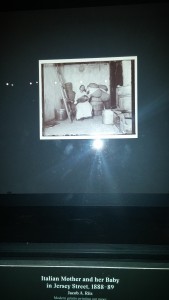The Jacob A. Riis exhibit at the Museum of the City of New York was an enlightening experience. Riis was a American photographer-journalist who famously photographed the poor and impoverished people of the late 1800s and compiled his findings in the book How the Other Half Lives: Studies Among the Tenements of New York. The middle and upper class American public was shocked at the inhumane living conditions of the “other half” of the country, as many of these people lived in dreadful, crowded, dangerous tenement houses. Those people, often immigrants or ethnic minorities, could barely afford housing or food, let alone up-to-date fashion.
The exhibit displayed Riis’ original photo negatives, lantern slides, letters, manuscripts, wood engravings, and halftones. The lantern slides, as Riis was one of the first to use flash photography, were mounted in paper frames covered by glass in multiple rows of long, dark, wooden display structures which evoked a sense of age. These slides were much smaller than I thought they would be; they are each about two inches up and across, and have descriptions and dates in text underneath. The glass made it difficult to take photos of the slides. I had to squint in order to read the text properly.
I thought the setup was well-designed, though some of the text could be bigger.
In the back of the room were a few benches, a beautiful old-timey projector (pictured), and a video of a slideshow with audio recreating two of Riis’ popular lectures where he spoke about the people and situations he saw during his photojournalism. Some of the things he said were likely accepted, popular opinions of the time, but they would definitely be considered offensive today. I was offending on some of the subjects’ behalves.
Overall, I learned a lot from this exhibit and would recommend it to others for a deeper understanding of the history of the people and city planning of New York. The exhibit is a testament to New York City’s dark history in human rights violations, though they did not exist at the time.



Hi Rui,
Very nice post. Your writing is strong and evocative. I admire how you focused on the technical aspect of the exhibit and how the pieces were displayed. This is a very important factor for artists (and museums) to consider when displaying work and artifacts.
I found myself wondering more about what you described as the offensive nature of Riis’s speeches. I’m curious to hear what comments he made that you thought would be considered offensive today. It’s amazing how our collective social and cultural perceptions change over time!